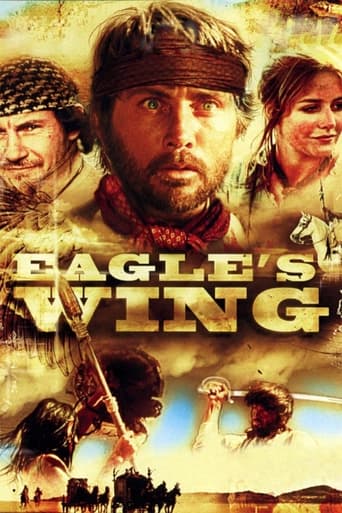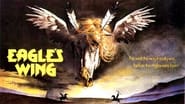acari27
Lets face it, there's nothing video clip slick about this movie, its 1979,but.what stands above all else is the plot - and a couple of exemplary performances, and some lovely pictures-and despite numerous stories that become one in this film-this is ultimately a tale about obsession with the horse. In this case heroism, riches, dignity and respect are all sacrificed for a white fine limbed high tailed arabian ..almost to the point of despair...it has its ugly beautiful moments, and as horrific as it is to get a white guy to play a native American (similar to the cringe we feel when whitey's play a chinaman in some films), something about waterstons acting makes it feel OK, and lets face it-its a ripper of a plot, no matter what era you put it in ..."help me" sheen whimpers..and to all of us similarly obsessed with the horse, we understand...and we support abandoning the girl..lament the loss, and fly across the plains with that white wildness, that we will never see again..to those that know what im talking about..im truly sorry for our loss...one of those rare beautiful films that you watch as a kid and never ever forget
classicsoncall
It's not likely you'll catch a Western like this again, good guys and bad guys have little meaning here. Martin Sheen and Sam Waterston are pitted against each other as an ex-foot soldier versus a Kiowa warrior, and the mismatch is palpable throughout. There's a great innovative scene where White Bull (Waterston) emerges from a waterhole to ambush Pike (Sheen), in the tradition of your best horror film surprises. That's one of the highlights in a story that ofttimes meanders back and forth with little action. At one point, Waterston is featured in a great Iron Eyes Cody profile that attests to his regal bearing, which director Anthony Harvey uses to tease a possible romantic involvement between the Indian and his captive blonde beauty (Caroline Langrish). That story line goes nowhere, but draws on more than a single exchange of amorous glances between the two.Martin Sheen gets to inject some humor into the cat and mouse game with some of the few lines of dialog the film actually uses; for his part, White Bull remains entirely silent throughout. It complements his mysterious nature, and the ruse with the tricked out dagger that takes out the thieving Mexican was a nice touch. Sheen does a remarkable job convulsing from that arrow to the leg from White Bull, so much so that you feel his pain.In the set up for the horseback duel finale, one expects a decisive outcome without knowing who'll win, but again, your standard Western conventions don't bear out. White Bull acknowledges Pike's temerity and allows him to live, and his thundering dust cloud ride into the sunset sets both men free. The ending though, managed to elicit an unintended chuckle just like Vincent Price does in the closing sequence of "The Fly", when Judith and Pike separately plead their case to the heavens - "Please, help me".
julia_leite
I have just read what I believe to be an analysis of this film by a lyrical Irishman. Lovely to read.However, a concise analysis of this film is that it is a interweaving of the seven deadly sins with the four types of justice.Envy, greed, pride, sloth, anger, etc. and justice in the forms of retributive, distributive, blind, and divine.I could demonstrate three examples of each, one for each of the three protagonists; however, it is much more fun to note them for oneself.This is an excellent film.Don't miss it.
alice liddell
This splicing of THE SEARCHERS is one of the weirdest films I've ever seen, filmed by a Briton in a strange, unfamiliar Mexico. It's often said that the best films about America are made by foreigners, who can approach the familiar with an outsider's eye. But this crackpot film is something else. Though set ostensibly in post-Civil War America, this isn't an America recognisable from myth, cinema, TV etc. The film has an air of timeless fable about it, while dealing specifically with Western mythology.Director Harvey uses the title horse as a focus for interconnecting stories, all dealing with the traditional Western clash of the primitive and civilisation. The former seems to have the upper hand. The vast scrub and desert of the film's landscape is unbroken, ripe for allegories of the mind. The only brief sites of civilisation are a stagecoach of missionaries and landowners, and their hacienda, from both of which derive behaviour that is anything but civilised.The basic story intercuts three stories. In one, an aimless deserter, Pike, having lost his trading partner, steals a miraculous horse, Eagle's Wing, so-called because of its grace and speed. In the second, an Indian, White Bull, owner of this horse, waylays a stagecoach, and kidnaps one of its female occupants. In the third, the Spanish men sent to find her ignore this quest in favour of a murderous, plundering spree.Although a revisionist Western, the treatment of the Indian is problematic. Unlike Pike, his character is never explained, forever inscrutable, denied a voice, except for an excruciating snatch of song. When he's not a strange Other, he's a symbol, whose role isn't entirely worked out - at one point a savage brute, at another he epitomises nature and freedom.But Pike notes at the beginning that the film will attend to the period of primitivism before civilisation. In many ways the film resembles 2001 - A SPACE ODYSSEY, especially its opening sequence. Part of the film's power lies in the connections made between the three disparate characters, forcing us to view the mythic struggles and quests in a different light. Indian culture and Catholicism is linked by superstition, ritual, greed and murder. Both Pike and White Bull are musical and alcoholic. White Bull is demonised by both Pike and the abductee as a 'bastard', unwittingly revealing the tactic of illegitimacy used by colonising whites who infantilised the natives, becoming themselves 'necessary' fathers.Unlike a traditional Western, concerned with making history, civilisation, and progress, this film is a double detective story, interrogating the past, tracks, remains.What gives this film its remarkable uniqueness, I think, is, despite Maltin's racism, its Britishness. The climactic stand-off is more like an Arthurian joust. The film itself bravely eschews dialogue for the most part, creating the kind of visual and aural tapestry Malick missed in THE THIN RED LINE, and something few Hollywood directors would have dared. The existential doubling and quest motifs are more European myth than American (resembling another British Harvey Keitel movie, THE DUELLISTS).Most astonishing is the use of nature. Most Westerns use landscape as an awe-inspiring backdrop: there is little sense of actually living in the West. In many ways, EAGLE'S WING is like a Powell and Pressberger film, with nature a powerful, pantheistic character in its own right - alive, dangerous, hostile, beautiful. There is a sublime scene reminiscent of A CANTERBURY TALE, when jewellery left as a trap by White Bull in the trees is suddenly blown in the wind: there is a haunting, tingling, magical, thrilling effect more reminiscent of the Arabian Nights than a horse opera. Heartstopping.




